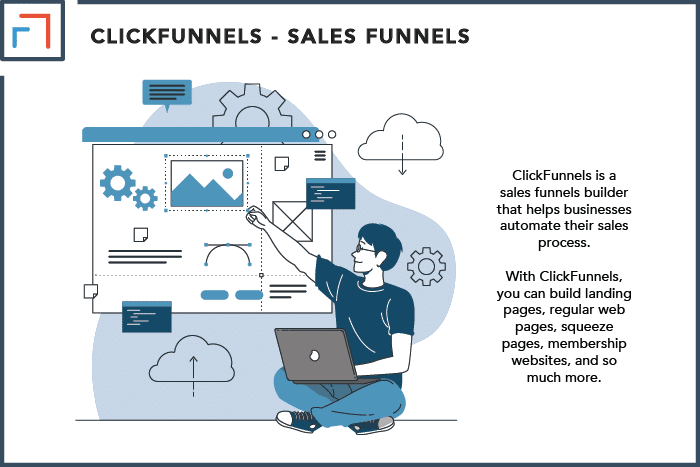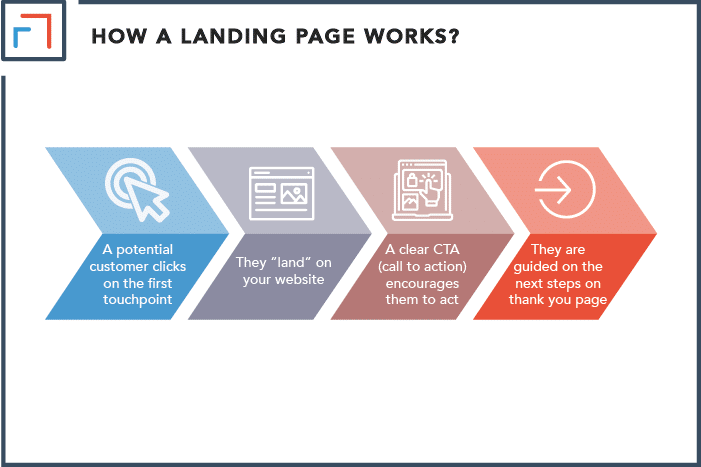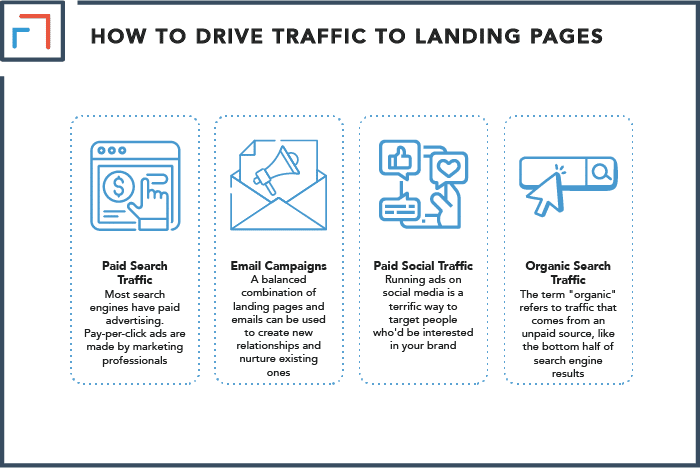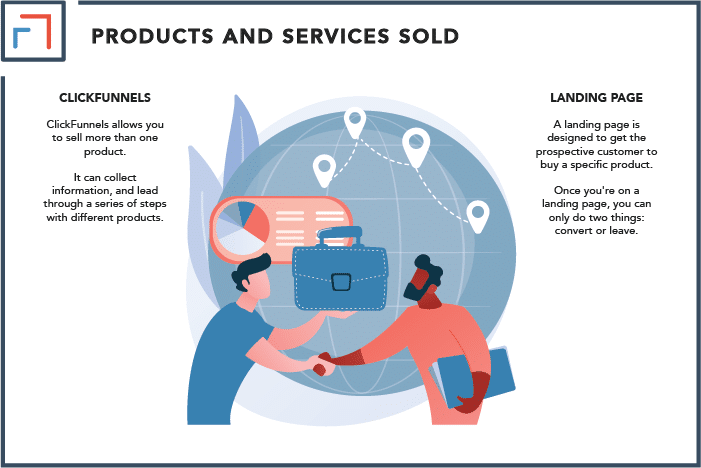At first glance, ClickFunnels and landing pages appear very similar. However, if you dig deeper, you’ll notice that there are several differences between them. So, how are they different?
The main difference between ClickFunnels and a landing page is that landing pages use a single page to convert. In contrast, ClickFunnels uses a sequence of pages to guide the customer towards conversion. ClickFunnels also collects more data from the visitor than a landing page does.
In this article, we’ll look at ClickFunnels and landing pages in detail. Keep reading to learn the differences between them.
What Is ClickFunnels?
ClickFunnels is a sales funnels builder that helps businesses automate their sales process. With ClickFunnels, you can build landing pages, regular web pages, squeeze pages, membership websites, and so much more.
Before we explore the difference in-depth, we first need to gain a separate understanding of ClickFunnels and landing pages.
Also, you need to know how sales funnels work to understand the difference between ClickFunnels and landing pages.
Landing pages are only a small piece of the whole.

1. What Is a Sales Funnel?
Unlike a landing page (which is a single page focused on conversion), a sales funnel is a series of pages that lead to a conversion event. The prospective customer enters the funnel through a paid ad, social media post, or email. They are then directed to the landing page of the product or service.
From the landing page, leads may click through several other pages of upsells and downsells before finally converting.
Sales funnels can either be long or short. Short sales funnels are more popular because they have a higher conversion rate.
The visitor can get to the point quicker if the funnel is short.
While long funnels could drive prospects away if they’re too long, they collect more of their data, which might be useful for driving conversions later on.
2. How It Works?
The top of a sales funnel consists of an audience that doesn’t know about your product or service (cold audience), while the bottom is made up of customers who are just about to convert.
As a result, every stage of a sales funnel requires a different approach that’s customized to the intent of the prospective customer.
This path is not linear and can take a few additional actions (downsells and upsells) before they finally convert.
Here’s an example:
Let’s say you’re a fitness expert, and your goal is to have people sign up for your service or program. This is an example of a sales funnel you can set up:
1. A paid ad or interesting content leads traffic to your website (top of the funnel.)
2. The landing page offers a calendar with a checklist of weekly habits the visitor can form to get healthier. The visitor can access this calendar by providing their email address (capture lead.)
3. The next page offers a product that goes along with your advice, e.g., weight loss tea (first upsell.)
4. At the same time, you can start sending them emails with relevant information, blog posts, discounts on products, and giveaways.
5. Finally, the person is guided to a sign-up form for your program (bottom of the funnel.)
3. When to Use ClickFunnels?
You should use ClickFunnels if you want to automate your sales process but also gather precise data on each step of the customer’s journey to conversion. With ClickFunnels, you have an active sales software that observes the customer’s behavior at each stage of the funnel.
In addition, it gives you the chance to adjust your offers based on this behavior and sell related services and products.
ClickFunnels has become increasingly popular in the recent past with both product and services-based businesses.
Besides automating your sales, it also helps you plan and optimize your marketing strategy based on customer behavior.
What Are Landing Pages?
A landing page is a standalone page created specifically to be a front for a marketing campaign. The only goal of the landing page is to convert the visitor into a customer by either signing them up for the service, selling them the product, or at least adding them to the mailing list.
At face value, a landing page looks like a traditional website page. However, it’s different because it has a single goal: conversion.
Therefore, it has a simple design with every aspect focused on action.
It acts like a bridge between the first touchpoint, where the visitor was redirected to your website (e.g., intriguing content or paid ad) and conversion.
1. How Landing Pages Work?
Here’s a simplified example of how a landing page works:
- A potential customer clicks on the first touchpoint, redirecting them to the landing page.
- They “land” on your website.
- A clear CTA (call to action) encourages them to act.
- They are redirected to the “thank you” page, where they’re guided on the next steps (download link/ check your inbox/ product is shipped etc.)

2. Types of Landing Pages
Although you will see many variations of landing pages depending on the business’ specifics, there are two primary types of landing pages.
Lead Generating Landing Pages
Also known as “lead capture,” or “lead gen,” these landing pages are focused on collecting leads for prospective customers.
They mostly use a blank form as their CTA, collecting important visitor data such as names and email addresses.
Companies selling high-ticket items and B2B marketers use this type of landing page to gather a list of potential customers.
Sometimes they also offer complimentary items like ebooks and webinars in exchange for the information.
Ecommerce companies also use these lists to provide free shipping and other special deals.
Click-Through Landing Pages
These landing pages are solely focused on conversion.
SaaS and eCommerce marketers frequently use click-through landing pages to go straight for the subscription or sale.
Usually, their CTA is a single button inviting the visitor into the checkout flow (like the play store) or to complete the transaction.
3. When to Use a Landing Page?
Landing pages are excellent when you have a single conversion goal. Their simple, minimalist design reduces your customer acquisition costs while increasing the conversion rate. This is because, unlike a website, which is focused on showcasing your brand’s value to visitors, a landing page concentrates on conversion.
Basically, when someone visits a landing page, there are only two possible outcomes: leave or convert.
As a result, a landing page works best when you’ve already invested in other ways of promoting your business and are only looking for a final touchpoint.
This also makes landing pages ideal assets when you’re staging giveaways and discounts.
For instance, if you’re running ads for a consulting business, your landing page could contain a calendar with time slots available for booking.
Each booked time slot is a conversion.
4. How to Drive Traffic to Landing Pages?
For a landing page to work, it needs to have as many visitors as possible. Fortunately, there are many ways to drive traffic to landing pages.
Let’s look at some of them.
Paid Search Traffic
Most search engines have paid advertising.
So, if you search for anything (say “the best landing pages,”), there will be a clearly indicated ad at the top of the results page.
Unlike other results on the page, pay-per-click ads are made by marketing professionals.
Anyone who clicks will probably be targeted based on their demographic data, search item, and other information revealed by their browsing history.
This makes them prospective customers. Typically, when you create a pay-per-click ad, you also get to choose where it redirects them.
So, you could choose to send them to your website.
However, it’s much better to create a stand-alone landing page that corresponds with your ad copy and a clear CTA.
Email Campaigns
Email is hailed as the best for its broad reach and low costs compared to other marketing channels.
In fact, a 2018 study by the Radicati Group projected there would be over 4 billion email users in the world by 2022.
A balanced combination of landing pages and emails can be used to create new relationships and nurture existing ones.
With a long contact list, you can craft enticing emails on new offers and giveaways, redirecting your readers to the landing page, which will have a CTA.
Paid Social Traffic
Running ads on social media is a terrific way to target people who’d be interested in your brand even when they aren’t in the market yet.
Instead of targeting people who type “the best flowers” on Google, you can target people who’ve added “flowers” as interests in their Facebook profile.
That way, you can connect with customers before they start looking for the product or want it.
Apart from advanced targeting features, each social network also has its unique characteristics.
For example, Instagram is great for lifestyle products with visual appeal, while LinkedIn is great for B2-B advertisers trying to reach professionals in specific industries.
Organic Search Traffic
The term “organic” refers to traffic that comes from an unpaid source, like the bottom half of search engine results.
By creating intriguing, helpful content on your landing pages or website, you can get better rankings on search engines.
Calling it “unpaid” might be a little misleading because it doesn’t mean that you can rise through the ranks without time and money.
There’s a whole industry of professionals dedicated to getting as much organic traffic from Google by creating brilliant content. That’s SEO in a nutshell.

The Difference Between ClickFunnels and Landing Pages
Now that we understand what ClickFunnels and landing pages are, we can talk about their differences. Here are the main ones:
| Point of difference | ClickFunnels | Landing Page |
|---|---|---|
Design | Complex design with the customer’s journey to conversion as a priority. | Simple design with conversion in mind. |
Products and services sold | Multiple related products and services can be sold. | Made to sell a single product or service. |
| Conversion rate | Lower conversion rate. | High conversion rate. |
| Audience | Cold audience. | People who are familiar with the brand. |
| Data collected | Lots of prospective customer data collected. | Very little data collected. |
1. Design
The primary difference between landing pages and ClickFunnels is their design.
Landing pages have a simple, goal-oriented design, while the ClickFunnels funnels are a complicated web of pages with different goals.
A landing page is a stand-alone web page designed with a specific goal.
These goals might include creating an advertising campaign, marketing to an audience, or gathering visitors’ information.
This is where you send your targeted pay-per-click traffic. It focuses on one sole product that is marketed to anyone who is led there.
While landing pages may have multiple sections, the call to action is usually centered, with a huge button to buy the product or subscribe to the service.
ClickFunnels, on the other hand, comprises many web pages that direct a customer towards their final sale.
A customer may be redirected to 2 or more pages before there is a call to action on the initial product.
2. Products and Services Sold
A landing page is designed to get the prospective customer to buy a specific product. Once you’re on a landing page, you can only do two things: convert or leave.
There are no links to other products and services or additional information. ClickFunnels, on the other hand, allows you to sell more than one product.
After the first touchpoint, the prospective customer is led to a landing page, where they give their information.
They are then taken through a series of steps (upsells and downsells,) each with a different product.
Therefore, if the customer got onto the top of the funnel for a fitness program, they might also end up buying health products, workout equipment, and fitness ebooks.
All these come before subscribing to the actual fitness program.

3. Conversion Rate
While landing pages have a simple design, they also have a higher conversion rate.
This is because when the prospective customer “lands” on the page, they have the option to buy the product or subscribe to the service.
This makes landing pages ideal investments for pay-per-click advertisements.
Since ClickFunnels funnels are often long, they sometimes lose the prospective customer before they convert.
On the upside, each funnel collects more of the lead’s data, which can later be used to reel them back to conversion.
4. Audience
Landing pages are targeted toward people who are already familiar with the brand.
As a result, they have probably already decided whether they’re interested when they come to the page.
ClickFunnels, on the other hand, is primarily directed to a cold audience (those who don’t know about the brand).
Therefore, ClickFunnels begins by introducing them to the brand before they eventually convert.
5. Data Collected
A landing page’s sole focus is for the customer to convert.
They don’t ask for too much information from them but instead concentrate on selling the product or service.
In contrast, ClickFunnels value data as much as conversion. This data is later used to turn leads into conversions or develop a marketing strategy.
With the data collected through ClickFunnels, a business can tell which aspects of their business are most attractive to customers and which ones they should change.
To Wrap It Up
ClickFunnels and landing pages are both excellent tools to automate your sales.
While it might look like they have the same purpose, they are different in design and how they work.
They have different functions, and they are designed to address the diverse needs of customers.
Most ClickFunnels funnels will include landing pages, but they are not one and the same.
The products and services that are sold by each and the data used also differ in significant ways.
It is essential for any marketer and budding funnel enthusiast to understand these two marketing tools so they can use each one appropriately.
